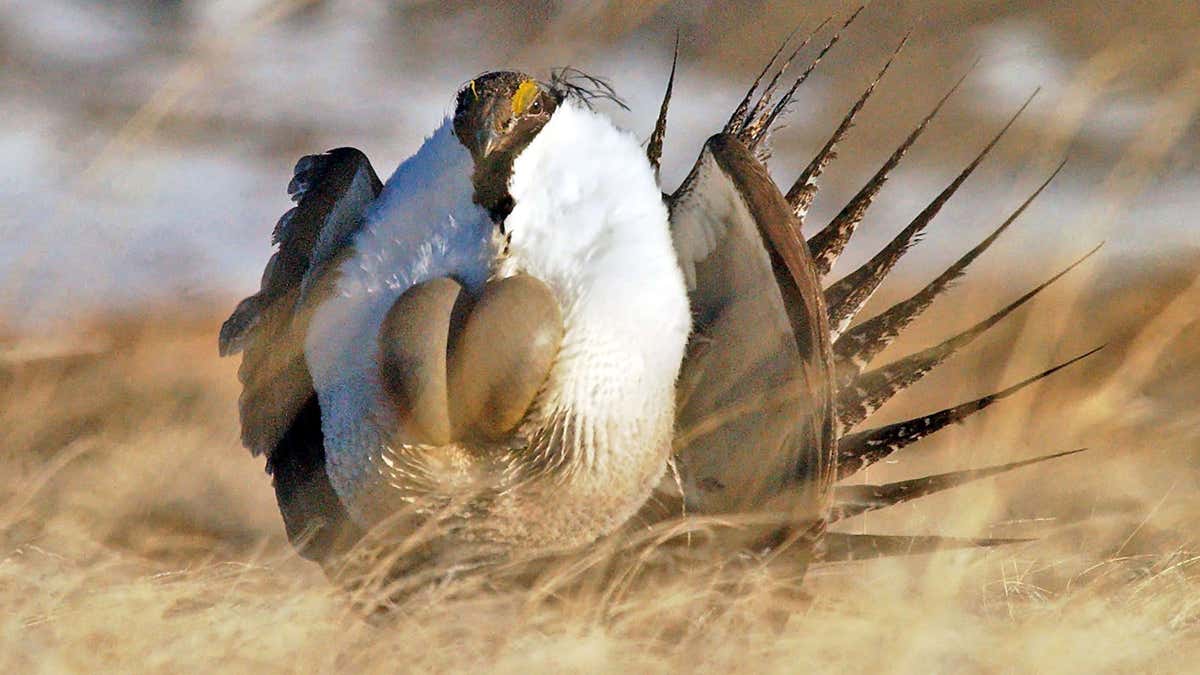
April 15, 2008: A male sage grouse performs his "strut" near Rawlins, Wyo. (AP)
The federal government plans on spending more than $200 million over the next three years on programs to protect the sage grouse in Western states, regardless of whether the bird received federal protections, U.S. Agriculture Secretary Tom Vilsack said on Thursday.
Vilsack told The Associated Press he wants to almost double the protected habitat for the bird to 8 million acres by 2018. He also promised more will be done to limit residential development in sage grouse habitat and to restore wetlands used by the birds.
Nearly half of the $211 million the government plans to invest over the next three years will go toward buying conservation easements. Land under easement can only be used for grazing and cannot be developed for other purposes. Another $93 million will be used for habitat restoration and $18 million will pay for technical assistance to landowners.
"Landowners are stepping up, they're doing their part, and we're already seeing the benefits," Vilsack said. More than 1,100 private landowners have signed up thus far for the program across 11 states, he said.
The effort to save the sage grouse is part of the Obama administration’s campaign to demonstrate its commitment to staving off further declines in grouse populations and to avoid a proposal to list the bird as endangered.
The bird's fate has become a potential political liability heading into the 2016 election. Federal protections could prompt limits on energy drilling, grazing and other activities across the grouse's 11-state range.
Some Republicans have seized on the issued as supposed evidence of wildlife protection laws run amok. They say it underscores the urgent need to scale back the federal Endangered Species Act. Sage grouse were proposed for protections under the act in 2010, but they were not put in place because of other priorities.
The bird, once numbered in millions, have decreased in population to between 200,000 to 500,000.
Vilsack said the administration was seeking to balance concerns over the bird's future with economic reality.
"Diversity of wildlife is important. Diversity of economy is important as well," he said in an interview. "We want our working lands to be productive, and we also want to make sure we maintain what's unique to the value of that terrain."
The U.S. Fish and Wildlife Service faces a Sept. 30 deadline to decide whether protections are needed.
The future spending Vilsack described is in addition to more than $400 million spent on sage grouse conservation since 2010. Future spending pledges — and additional money from states, conservation groups and others — would bump the overall tally to more than $750 million for sage grouse through 2018, according to federal officials.
In Oregon, more than $18 million has been spent on 178 sage grouse-related projects, officials said. Participating landowners have received assurances from the government that if they participate and invest in sage grouse conservation now, they won't have to face new restrictions if the bird is listed as endangered.
Roaring Springs Ranch in southeastern Oregon has gone a step further. The ranch hired a wildlife biologist and is conducting its own research to figure out which parts of the ranch provide good habitat for the sage grouse.
The ranch also cuts down juniper trees to improve habitat, and uses prescribed burns and fire breaks to stop wildfires that can be devastating to the birds, said biologist Andrew Shields. This year, the ranch saw a 25 percent increase in sage grouse on 250,000 acres of its private land.
"Doing these initiatives from the ground up is a lot more effective," Shields said. "This could be a new way of doing conservation."
The Associated Press contributed to this report.




